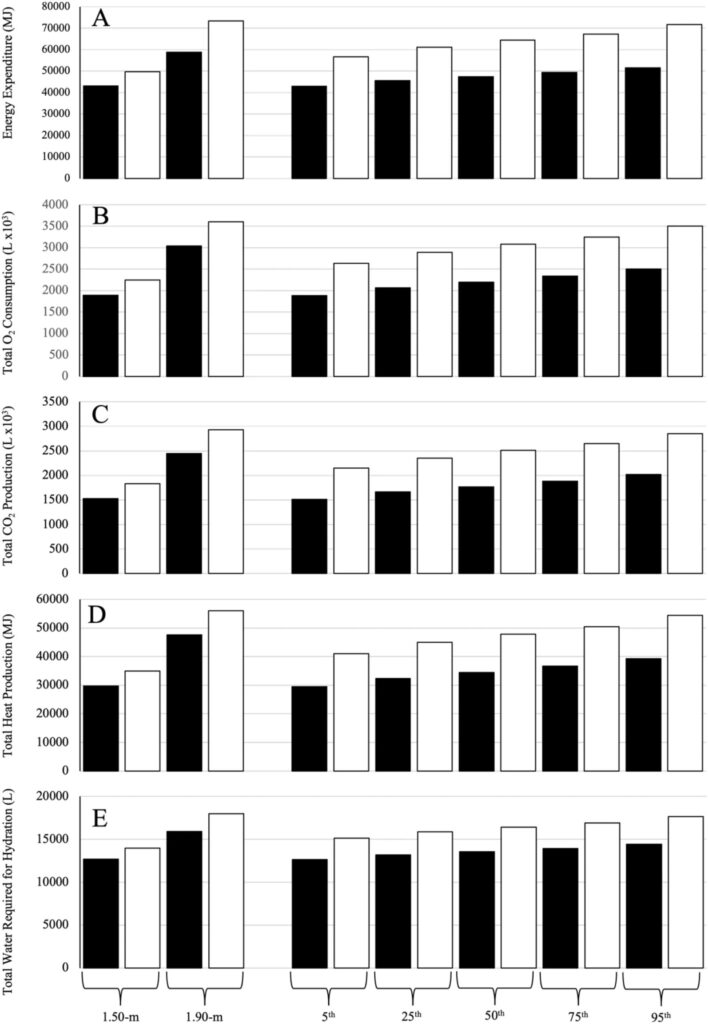We all know Neil Armstrong’s famous words: “That’s one small step for man. One giant leap for mankind.” From the beginning, American space travel has been a male-dominated industry. In recent years, the field of space exploration has witnessed a significant shift towards inclusivity, with more women actively participating in missions and research. While both men and women have proven themselves capable in the challenging environment of space, there are compelling reasons why women may be particularly well-suited for the rigors of space exploration. One of the foremost considerations in planning space missions is the management of resources. From spacecraft design to supply logistics, every pound of payload is carefully calculated. “Females are, on average, smaller and lighter than males” (Jackson 2023). Their smaller size translates into lower mass requirements for space missions, allowing for more efficient resource utilization (Figure 1). “Female astronauts have lower water requirements for hydration, total energy expenditure, oxygen (O2) consumption, carbon dioxide (CO2), and metabolic heat production” (Jackson 2023).

In the context of extended space missions, where resources are finite and resupply options are limited, the ability to make the most of available supplies is a critical factor. Women’s smaller physical footprint ensures that spacecraft can carry more provisions for longer missions, contributing to the sustainability of space exploration endeavors. Smaller body masses result in lower fuel requirements for propulsion systems. This is particularly significant in missions where every kilogram of weight carries a substantial cost in terms of fuel consumption. Women’s smaller physiques contribute to overall fuel efficiency, making it easier to reach distant celestial bodies with the available resources. While the advantages of smaller physiques in space are compelling, it is essential to address concerns related to the design of space toilets. Historically, space toilets have been engineered with the male anatomy in mind, posing challenges for female astronauts (Figure 2). They are designed to recycle water from urine, but not when any other matter is detected; ie. fecal matter or period blood. “Problems [occur] when period blood is involved, and as a result, most female astronauts will use contraceptive methods to suppress their periods” (Beall 2019). The intricate design of these toilets, involving suction mechanisms and specially shaped funnels, can be less accommodating for women. In conclusion, the discussion surrounding the potential advantages of women’s smaller physiques in space exploration sheds light on fascinating considerations for future missions. The efficiency gains in resource utilization, spacecraft design, and fuel consumption are compelling factors to explore. However, it is crucial to recognize that astronaut selection should primarily focus on the capabilities, skills, and qualifications of individuals, rather than solely emphasizing physical attributes.

References
Beall, Abigail. “How NASA Failed Female Astronauts and Built Space Travel for Men.” WIRED UK, May 22, 2019. https://www.wired.co.uk/article/nasa-moon-women-astronauts.
Fischer, Jack. Nasa 2023
Jackson, Justin. “Study Finds Female Astronauts More Efficient, Suggesting Future Space Missions with All-Female Crews.” Phys.org, May 5, 2023. https://phys.org/news/2023-05-female-astronauts-efficient-future-space.html#:~:text=Researchers%20from%20the%20Space%20Medicine,metabolic%20heat%20production%20during%20space.
Jackson, Libby. “Women (Probably) Make for Better Astronauts. So Should the First Crew to Mars Be All-Female?” BBC Science Focus Magazine – Science, Nature, technology, q&as, May 22, 2023. https://www.sciencefocus.com/space/women-female-mars.
Scientific Reports (2023). DOI: 10.1038/s41598-023-31713-6
Further Reading:
https://www.nytimes.com/2019/07/23/science/moon-landing-women-apollo-11.html https://www.nationalgeographic.com/magazine/article/space-travel-four-ways-women-are-a-better-fit-than-men
